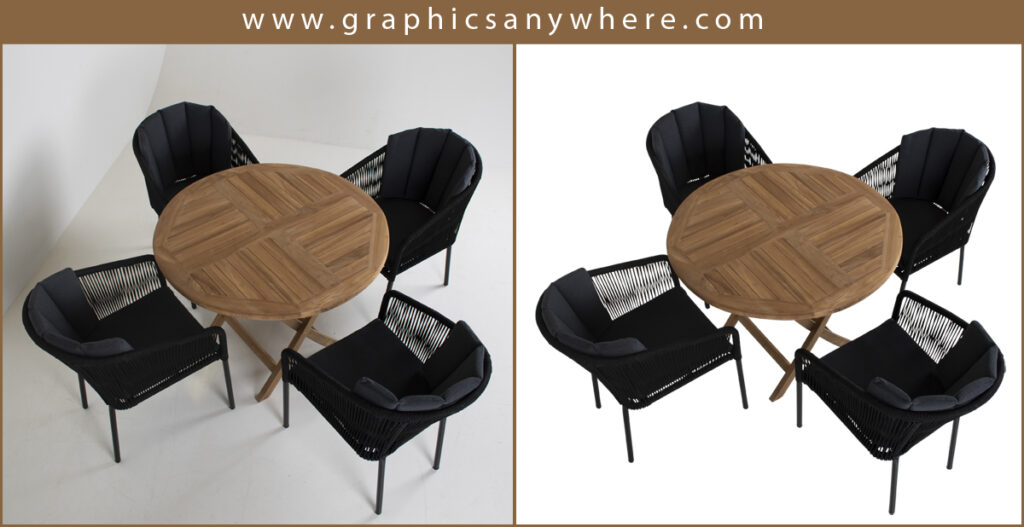Both Handmade clipping paths and automation clipping paths are methods used in image editing to isolate subjects from their backgrounds. They each have their own advantages and disadvantages depending on the specific needs of the project.
Handmade Clipping Path
Pros:
- Precision: Handmade clipping paths are typically more accurate and detailed, especially around complex edges like hair or fur.
- Quality Control: Because they are created by a human, there is a higher level of quality control and the ability to make adjustments on the fly.
- Customization: Handmade paths can be tailored specifically to the requirements of the project, allowing for more creative and precise results.
- Complex Objects: Better suited for complex objects with intricate details.
Cons:
- Time-Consuming: Creating a clipping path by hand can be very time-consuming, especially for high-volume projects or complex images.
- Cost: Typically more expensive due to the labor involved.

Automation Clipping Path
Pros:
- Speed: Automated tools can process images much faster than a human can, making them ideal for large batches of images.
- Cost-Effective: Generally less expensive than hiring a human to manually create clipping paths.
- Consistency: Automated tools can apply the same settings uniformly across many images, ensuring a consistent look.
Cons:
- Accuracy: Automated clipping paths may not be as precise, especially with complex edges or varying background colors.
- Customization: Limited customization options compared to handmade paths. Automated tools might not handle intricate details as well.
- Quality Control: Less control over the final output, which might require additional adjustments by a human editor.
Use Cases
Handmade Clipping Path is ideal for:
- High-end product photography
- Fashion and apparel images with complex edges
- Any project where precision and quality are paramount
Automation Clipping Path is suitable for:
- E-commerce sites with large volumes of images
- Simple objects with clear, distinct edges
- Projects with tight deadlines and limited budgets
Option for Choose
Choosing between handmade and automation clipping paths depends on the specific needs of your project. For high-quality, detailed work, handmade clipping paths are usually the better choice. For speed, efficiency, and cost-effectiveness, automated clipping paths are more suitable. In many cases, a hybrid approach may be used, where automated tools handle the bulk of the work and human editors make refinements as needed
Handmade clipping paths are often recommended for several key reasons, particularly when high-quality results are essential. Here are the primary factors that make handmade clipping paths a preferred choice in many scenarios:
1. Precision and Accuracy
- Complex Edges: Handmade clipping paths are superior at handling intricate and complex edges, such as hair, fur, or detailed product contours. A human can carefully trace these edges to ensure accuracy.
- Fine Details: For images with small or delicate details, manual clipping paths provide the precision needed to maintain the integrity of these elements.
2. Customization
- Tailored Adjustments: A human can make tailored adjustments based on the specific needs of each image. This includes customizing the path to fit unusual shapes or making creative adjustments that automated tools might not recognize.
- Creative Control: Designers can exercise creative control to ensure the path aligns perfectly with the intended final look of the image, which is crucial in high-end advertising and creative projects.
3. Quality Control
- Manual Review: Each path can be manually reviewed and adjusted to ensure the highest quality. This level of oversight ensures that errors are minimized and the final output meets professional standards.
- Consistency: While automation can provide consistent settings, handmade paths ensure consistent quality, as the same level of attention and detail is applied to each image.
4. Handling Complex Images
- Varied Backgrounds: Images with varied or busy backgrounds can be challenging for automated tools. A human can navigate these complexities better, ensuring a cleaner and more accurate separation.
- Multiple Layers: For images requiring multiple layers of clipping paths, a manual approach allows for better organization and more precise layering.

5. High-End Projects
- Professional Photography: High-end product photography, fashion photography, and other professional-grade images benefit significantly from the detailed work that handmade clipping paths provide.
- Brand Image: Maintaining a high-quality brand image often requires the meticulous attention to detail that only handmade clipping paths can offer.
6. Reliability in Difficult Situations
- Inconsistent Lighting: Images with inconsistent lighting, shadows, or reflections can pose a challenge for automated tools, whereas a human can account for these variations more effectively.
- Challenging Textures: Textured surfaces or transparent objects (like glass) often need the nuanced touch of a human editor to achieve a realistic and clean separation.
Decision for you
Handmade clipping paths are suggested because they ensure a higher level of precision, customization, and quality control, particularly for complex and high-stakes projects. They provide the flexibility and attention to detail that automated tools often lack, making them the preferred choice for professional and detailed image editing needs.



